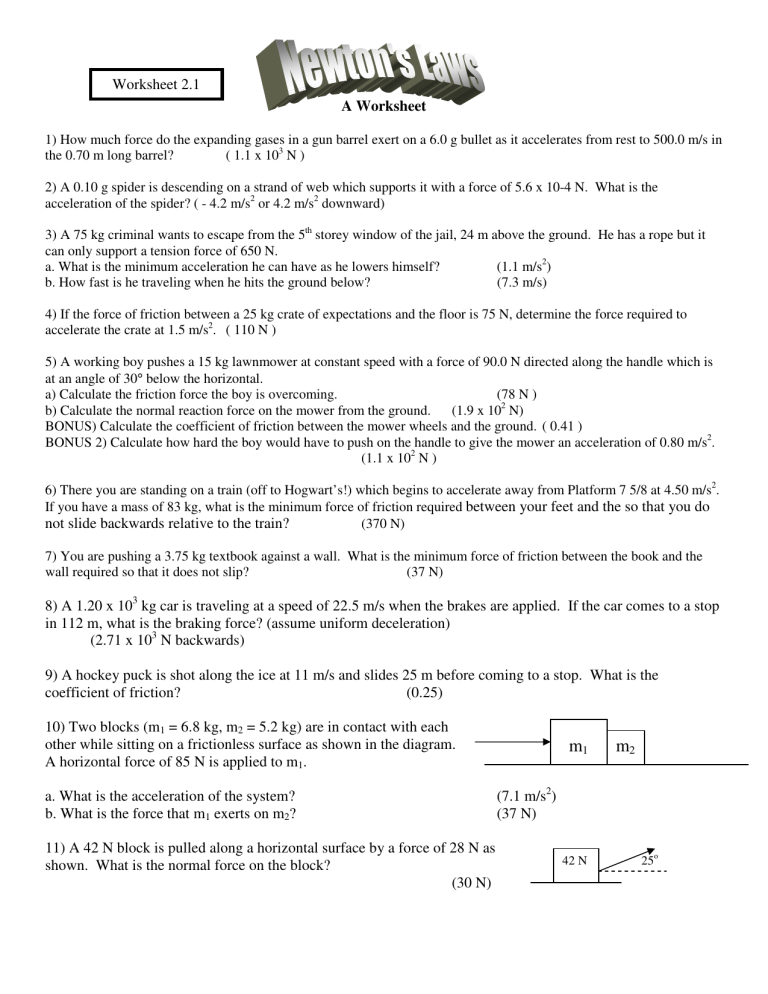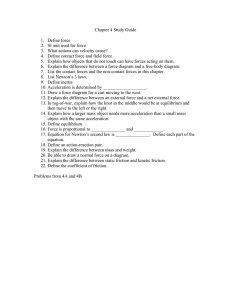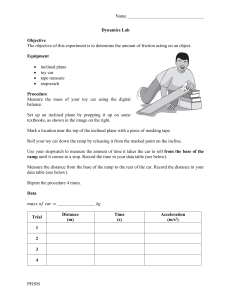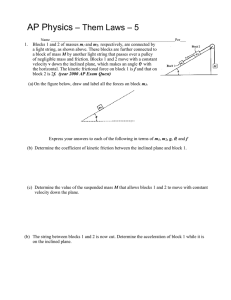
Worksheet 2.1 A Worksheet 1) How much force do the expanding gases in a gun barrel exert on a 6.0 g bullet as it accelerates from rest to 500.0 m/s in the 0.70 m long barrel? ( 1.1 x 103 N ) 2) A 0.10 g spider is descending on a strand of web which supports it with a force of 5.6 x 10-4 N. What is the acceleration of the spider? ( - 4.2 m/s2 or 4.2 m/s2 downward) 3) A 75 kg criminal wants to escape from the 5th storey window of the jail, 24 m above the ground. He has a rope but it can only support a tension force of 650 N. a. What is the minimum acceleration he can have as he lowers himself? (1.1 m/s2) b. How fast is he traveling when he hits the ground below? (7.3 m/s) 4) If the force of friction between a 25 kg crate of expectations and the floor is 75 N, determine the force required to accelerate the crate at 1.5 m/s2. ( 110 N ) 5) A working boy pushes a 15 kg lawnmower at constant speed with a force of 90.0 N directed along the handle which is at an angle of 30° below the horizontal. a) Calculate the friction force the boy is overcoming. (78 N ) b) Calculate the normal reaction force on the mower from the ground. (1.9 x 102 N) BONUS) Calculate the coefficient of friction between the mower wheels and the ground. ( 0.41 ) BONUS 2) Calculate how hard the boy would have to push on the handle to give the mower an acceleration of 0.80 m/s2. (1.1 x 102 N ) 6) There you are standing on a train (off to Hogwart’s!) which begins to accelerate away from Platform 7 5/8 at 4.50 m/s2. If you have a mass of 83 kg, what is the minimum force of friction required between your feet and the so that you do (370 N) not slide backwards relative to the train? 7) You are pushing a 3.75 kg textbook against a wall. What is the minimum force of friction between the book and the wall required so that it does not slip? (37 N) 8) A 1.20 x 103 kg car is traveling at a speed of 22.5 m/s when the brakes are applied. If the car comes to a stop in 112 m, what is the braking force? (assume uniform deceleration) (2.71 x 103 N backwards) 9) A hockey puck is shot along the ice at 11 m/s and slides 25 m before coming to a stop. What is the coefficient of friction? (0.25) 10) Two blocks (m1 = 6.8 kg, m2 = 5.2 kg) are in contact with each other while sitting on a frictionless surface as shown in the diagram. A horizontal force of 85 N is applied to m1. a. What is the acceleration of the system? b. What is the force that m1 exerts on m2? 11) A 42 N block is pulled along a horizontal surface by a force of 28 N as shown. What is the normal force on the block? (30 N) m1 m2 (7.1 m/s2) (37 N) 42 N 25o 12) What is the tension in the cable of an 1.20 x 103 kg elevator that is a. accelerating downwards at 1.05 m/s2? (1.05 x 104 N) b. accelerating upwards at 1.05 m/s2? (1.30 x 104 N) c. moving down at a constant velocity? (1.18 x 104 N) 13) A 1.0kg box on a frictionless surface is attached to a 1.5 kg box as shown. What is the acceleration of the 1.0 kg box? (5.9 m/s2) 1.0 kg 1.5 kg 14) Two masses are hung from a frictionless pulley as shown. What is the acceleration of: a. the 1.5 kg block? (1.4 m/s2 up) b. the 2.0 kg block? (1.4 m/s2 down) 1.5 15) Two blocks are tied together as shown. IF a force of 20.0 N is applied to the 2.0 kg block: a. what is the acceleration of the blocks if the surface is frictionless? (4.0 m/s2) b. What is the tension in the string joining the two blocks? 3.0 kg 2.0 T = 20.0 N 2.0 kg (12 N) 16) Repeat question #4 when the coefficient of friction between the two blocks and the surface is 0.21. a. (1.9 m/s2) b. (12 N) Forces in Worksheet 2.2 1) Consider the following five force vectors. Sketch the following and draw the resultant (R). Do not draw a scaled vector diagram; merely make a sketch. Label each vector. Clearly label the resultant (R). i) B + D ii) E + B iii) A + C + D iv) B + E + D 78 N north 2) A 2.4 kg soccer ball is kicked by two players simultaneously as shown. a. Find the force on the ball. (89 N 28o E of N) b. Find the ball’s acceleration. (37 m/s2 28o E of N) 3) Two children pull a third child on a toboggan (shown from the top, assume up is north). Assuming that they pull on ropes that are parallel to the ground determine the magnitude of the force exerted on the toboggan. [174 N, 354o] 42 N east 66 N 33o 25o 130 N 4) A pack of five Artic wolves are exerting five different forces upon the carcass of a 500-kg dead polar bear. A top view showing the magnitude and direction of each of the five individual forces is shown in the diagram at the right. 30 N 45o 20 N 90o What is the resultant force? 25 N 0o o (39.4 N 324 ) 20 N 225o 50 N 270o Worksheet 2.3 1) A 7.6 kg object is at rest on an inclined plane. If the plane makes an angle with the horizontal of 33o what is the normal force acting on the object? (62 N) 2) A 7.6 kg object is pulled up an inclined plane. If the plane makes an angle with the horizontal of 33o and the coefficient of friction is 0.20, what is the force of friction? (12 N) 3) A 16.2 kg object slides down an inclined plane at a constant velocity. If the plane makes an angle of 25o, what is the normal force acting on the object? (144 N) 4) A 445 N box is sliding down a frictionless 25o inclined plane. Find the parallel component of the weight that causes the box to slide (188N) 5) A 325 N box is sliding down a frictionless 30.0o inclined plane. What is its acceleration? (4.90 m/s2) 6) A 435 N box is sliding down a 40.0o inclined plane. If the acceleration of the box is 0.250 m/s2, what is the force of friction acting on the box? (269 N) 7) A student pulls a 125 N object up a 25o incline. If the coefficient of friction is 0.180, what force must the student pull with to move the object at a constant velocity? Assume the applied force is parallel to the ramp (why would that matter?) (73.2 N) 8) Fluffy the cat slides freely down the long porcelain cat slide into the Beverly Hills pet pool. If the incline is 18° and µ = 0.10 determine the time it takes Fluffy to reach the bottom of the 10 m slide. (HINT: find a first, don’t worry about the cat’s mass, it cancels out) (3.1 s) 9) A trucker loses his brakes and hits the bottom of a runoff road (put there to protect against such a situation) at 150 km/h. The runoff road is inclined at 50° and friction against the truck is approximately equal to a sliding coefficient of 0.20. If the runoff road is 100 m long, is it long enough? (just barely, by 1.1 m) Worksheet 2.4 Two Objects with an Incline 1) Two blocks are tied together with a string as shown. If both the pulley and incline are frictionless find a) the direction and magnitude of acceleration on the 1.0 kg mass. (4.9m/s2 up the ramp) b) the tension in the string joining the blocks. (9.8 N) m2 = 1.0 kg m1 = 2.0 kg 30o 2) If the ramp and block in question 1 have a coefficient of friction of 0.135, what will be the block’s acceleration? (4.5 m/s2)



